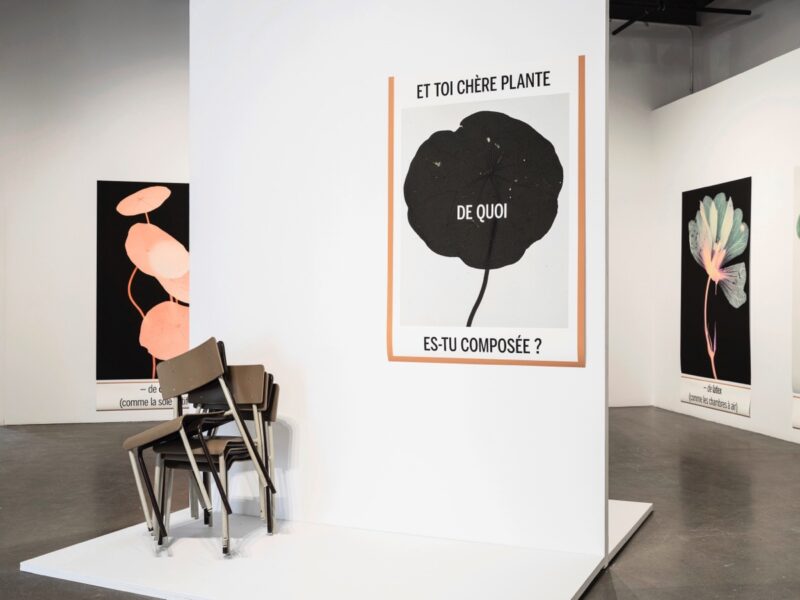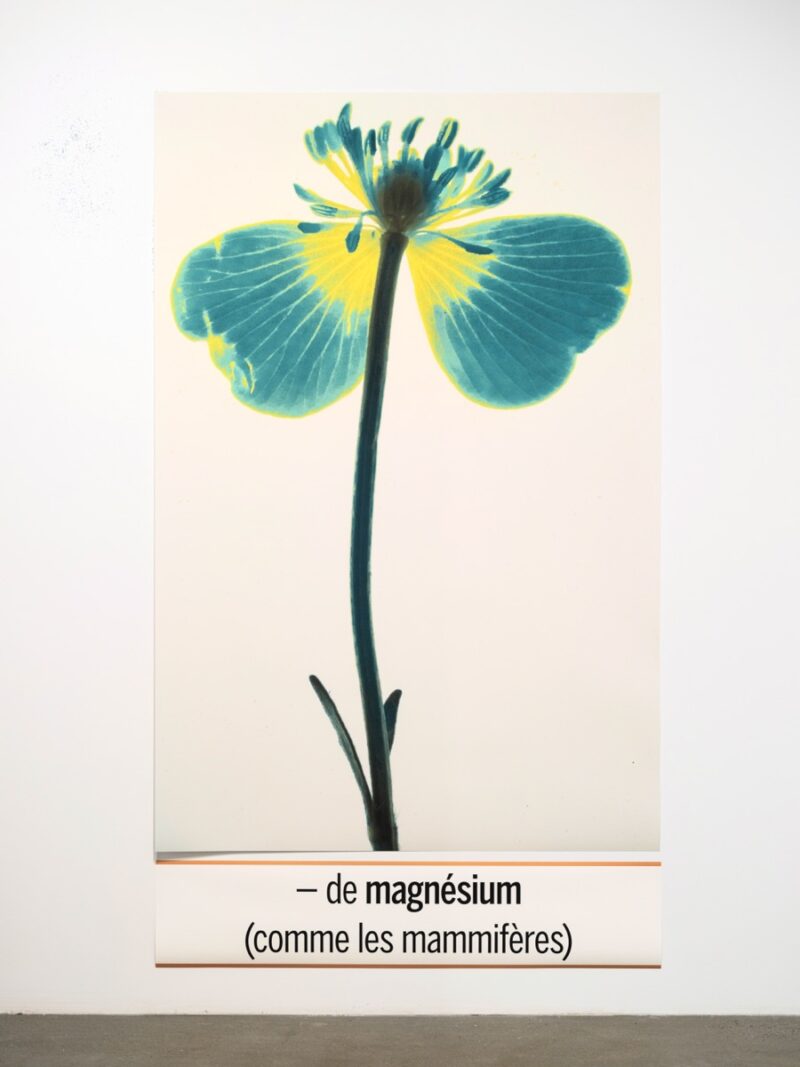[Fall 2024]
Et toi, chère plante ?
by Nathalie Côté
[EXCERPT]
After their transition from the cracks in the sidewalks of French cities to the gallery walls of Centre VU, the wildflowers and other “weeds” gathered and photographed by Suzanne Lafont are barely recognizable. It isn’t her intention to assemble a herbarium or give a botany lesson for the purpose of display or identification; rather, they are the subjects of her studies of colour, image, writing, and our relationships with nature. Lafont, a French contemporary artist who has been active for several decades, printed her large-format (230 × 150 cm) photographs on polypropylene in VU’s laboratories during a stay in Quebec City in fall 2023.
Her works were presented in the context of Manif d’art – La biennale de Québec, whose theme, “The Strength of Sleep,” finds new insight here with these plants emerging from the grey concrete. Flowers stubbornly blooming between the cobblestones are always fascinating – like the early-spring dandelions that burgeon in the most inimical places.
Lafont’s manipulation of the photographic images gives her experimental herbarium a sense of the surreal. The prints, with either black or white backgrounds, give the appearance of having been solarized. The original colours of the flowers have been changed; their stems are blue or red. Transformed, they acquire a luminosity that accentuates their fictitiousness. Many possible narratives on our relationship with nature arise. Here we see a bloom that resembles a daisy, there what could be an iris; but identifying them isn’t the goal.
They are the pretext for Lafont’s investigations on the ties between images and words – an idea that traverses all of her work, inscribing it in the tradition of conceptual art. The words printed on each photograph identify one of the components of the plant and one of its by-products, usually industrial in nature: isoprene (as in shoe soles), potassium (as in batteries), cellulose (as in artificial silk), aldehydes (as in Chanel No. 5), lipids (as in the brain). An almost-infinite number possibilities for association come to mind.
Lafont’s exploration of weeds began in 2017, and the result was presented at the Musée des Beaux-Arts de Bordeaux. The photographs, more understated, were associated with street names in the Gironde department’s prefecture and neighbouring towns, with historical figures, and with situations. In this series, Nouvelles espèces de compagnie (roman), she was already shining a light on neglected plants, but also denouncing human invasions of the natural world. In an interview with the museum’s director, Lafont noted that “wild nature no longer exists” and that weeds are becoming intertwined with the social world.
In the most recent variation of her herbarium, presented in Quebec City, Lafont was still challenging the exploitation of living things. Here, however, it was the chemical components of plants that determined the words associated with them. The concept thus perhaps grew more universal in scope.
In addition to the twenty images hanging on the walls, on a low wall in the centre of the gallery were two photographs of a plant that literally asked the question for visitors to ponder: “And you, dear plant, what are you made of?” Each photograph responded in its fashion.
Toward eco-responsible photography. This question might also be asked of the photographic support upon which Lafont’s photographs were printed: polypropylene. This material, though petroleum-based, is considered eco-responsible because it is recyclable (similar to yogurt containers), according to Vincent Drouin, the printing and mounting technician at VU, who guided Lafont in her choice. It goes without saying that the use of an eco-responsible support was a concern for her, given her longstanding interest in nature.
It’s also one of the questions raised by this exhibition, which probed matter and its components. It opens the door to consideration of an issue facing contemporary photography. Since early 2024, the artists of VU have been working on a project around eco-responsible photography, featuring a series of creative residencies, training courses, and roundtables. The artist-run centres SAGAMIE in Alma, Espaces F in Matane, and L’imprimerie in Montreal are working with VU to explore best printing practices. They’re looking for ways to replace halide silver photography and the chemical products required for developing film in the darkroom. Maybe they’ll even find a replacement for the petroleum-based photographic support. Artists and their works are certainly not among the biggest polluters on the planet, but these experiments may instigate new fields of exploration for photography. Translated by Käthe Roth
[ Complete issue, in print and digital version, available here: Ciel variable 127 – SISTERS, FIGHTERS, QUEENS ] [ Complete article in digital version available here: Et toi, chère plante?]



